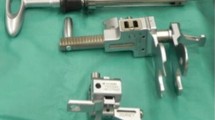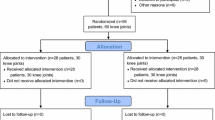Abstract
Purpose
Navigation-based total knee arthroplasty (TKA) has proven its value for restoration of the limb axis. However, patient-orientated results after TKA show a wide variation from the correct implantation technique. Nonphysiological kinematics without posterior femoral rollback and tibial internal rotation in flexion could be one reason for this. We postulated that a modified gap-balancing technique with navigation of the tibia alone, in comparison to a conventional navigated technique, would: (1) obtain lateral femoral rollback, (2) alter condylar liftoff without midflexion instability, (3) significantly differ in femoral and tibial cuts, (4) not be inferior in leg-axis restoration and (5) be comparable in clinical short-term scores.
Methods
In this prospective study, we compared in vivo navigation-based kinematics pre- and postoperatively of 40 consecutive TKA comprising 21 conventional navigation-based TKA and 19 TKA with the modified gap-balancing technique and a reduced navigation workflow. All cuts were double checked and compared with cuts proposed by the navigation system. Clinical results were assessed preoperatively and six months postoperatively.
Results
The modified gap-balancing technique resulted in significantly increased lateral femoral rollback (mean 16.3 mm) and lateral condylar liftoff (mean 1.3 mm) compared to the conventional group. The modified technique comprised an average of 2.1 mm less distal femoral resection and an average of 4° less external rotation and 3.5° more flexion of the femoral component compared with the control group. Average tibial resection height was 1.1 mm greater and average tibial slope was 0.5° elevated compared to the control group. A neutral leg axis was achieved in all cases. Results showed no significant differences in clinical scores between groups.
Conclusion
A partial navigation solely of the tibial cut can securely restore the leg axis. Modification of the surgical technique can possibly reproduce more physiological knee kinematics with higher lateral femoral rollback in flexion without midflexion instability. This might help reduce postoperative problems with the new implant and thus reduce the amount of unsatisfactory results. Despite equal short-term results, mid- to long-term results are needed to prove whether or not this correlates with better clinical results and at least equal implant longevity.

Similar content being viewed by others
References
Argenson J-NA, Komistek RD, Akizuki S (2007) In vivo biomechanics of unicondylar knee replacement performed using minimally invasive technique. Orthop 36:1100–1105
Baier C, Maderbacher G, Springorum HR, Zeman F, Fitz W, Schaumburger J, Grifka J, Beckmann J (2013) No difference in accuracy between pinless and conventional computer-assisted surgery in total knee arthroplasty. Knee Surg Sports Traumatol Arthrosc. Off. J. Esska
Baier C, Springorum H-R, Götz J, Schaumburger J, Lüring C, Grifka J, Beckmann J (2013) Comparing navigation-based in vivo knee kinematics pre- and postoperatively between a cruciate-retaining and a cruciate-substituting implant. Int Orthop 37:407–414
Bäthis H, Shafizadeh S, Paffrath T, Simanski C, Grifka J, Lüring C (2006) Are computer assisted total knee replacements more accurately placed? A meta-analysis of comparative studies. Orthop 35:1056–1065
Bellamy N, Buchanan WW, Goldsmith CH, Campbell J, Stitt LW (1988) Validation study of WOMAC: a health status instrument for measuring clinically important patient relevant outcomes to antirheumatic drug therapy in patients with osteoarthritis of the hip or knee. J Rheumatol 15:1833–1840
Bellemans J, Banks S, Victor J, Vandenneucker H, Moemans A (2002) Fluoroscopic analysis of the kinematics of deep flexion in total knee arthroplasty. Influence of posterior condylar offset. J Bone Joint Surg Br 84:50–53
Bertin KC, Komistek RD, Dennis DA, Hoff WA, Anderson DT, Langer T (2002) In vivo determination of posterior femoral rollback for subjects having a NexGen posterior cruciate-retaining total knee arthroplasty. J Arthroplasty 17:1040–1048
Bourne RB, Chesworth BM, Davis AM, Mahomed NN, Charron KDJ (2010) Patient satisfaction after total knee arthroplasty: who is satisfied and who is not? Clin Orthop 468:57–63
Cates HE, Komistek RD, Mahfouz MR, Schmidt MA, Anderle M (2008) In vivo comparison of knee kinematics for subjects having either a posterior stabilized or cruciate retaining high-flexion total knee arthroplasty. J Arthroplasty 23:1057–1067
Clarke HD, Scuderi GR (2003) Flexion instability in primary total knee replacement. J Knee Surg 16:123–128
Culliton SE, Bryant DM, Overend TJ, Macdonald SJ, Chesworth BM (2011) The relationship between expectations and satisfaction in patients undergoing primary total knee arthroplasty. J Arthroplasty
Dennis DA, Komistek RD, Kim RH, Sharma A (2010) Gap balancing versus measured resection technique for total knee arthroplasty. Clin Orthop 468:102–107
Dennis DA, Komistek RD, Mahfouz MR, Haas BD, Stiehl JB (2003) Multicenter determination of in vivo kinematics after total knee arthroplasty. Clin Orthop 37–57
Dennis DA, Komistek RD, Walker SA, Cheal EJ, Stiehl JB (2001) Femoral condylar liftoff in vivo in total knee arthroplasty. J Bone Joint Surg Br 83:33–39
Dennis DA, Mahfouz MR, Komistek RD, Hoff W (2005) In vivo determination of normal and anterior cruciate ligament-deficient knee kinematics. J Biomech 38:241–253
Fitz W, Sodha S, Reichmann W, Minas T (2012) Does a modified gap-balancing technique result in medial-pivot knee kinematics in cruciate-retaining total knee arthroplasty? A pilot study. Clin Orthop 470:91–98
Freeman MAR, Pinskerova V (2005) The movement of the normal tibio-femoral joint. J Biomech 38:197–208
Hill PF, Vedi V, Williams A, Iwaki H, Pinskerova V, Freeman MA (2000) Tibiofemoral movement 2: the loaded and unloaded living knee studied by MRI. J Bone Joint Surg Br 82:1196–1198
Insall J, Ranawat CS, Scott WN, Walker P (1976) Total condylar knee replacement: preliminary report. Clin Orthop 149–154
Insall JN, Dorr LD, Scott RD, Scott WN (1989) Rationale of the Knee Society clinical rating system. Clin Orthop 13–14
Johal P, Williams A, Wragg P, Hunt D, Gedroyc W (2005) Tibio-femoral movement in the living knee. A study of weight bearing and non-weight bearing knee kinematics using “interventional” MRI. J Biomech 38:269–276
Li G, Most E, Sultan PG, Schule S, Zayontz S, Park SE, Rubash HE (2004) Knee kinematics with a high-flexion posterior stabilized total knee prosthesis: an in vitro robotic experimental investigation. J Bone Joint Surg Am 86-A:1721–1729
Liu Y-L, Chen W-C, Yeh W-L, McClean CJ, Huang C-H, Lin K-J, Cheng C-K (2011) Mimicking anatomical condylar configuration into knee prosthesis could improve knee kinematics after TKA—a computational simulation. Clin Biomech. Bristol Avon
Lopez-Olivo MA, Landon GC, Siff SJ, Edelstein D, Pak C, Kallen MA, Stanley M, Zhang H, Robinson KC, Suarez-Almazor ME (2011) Psychosocial determinants of outcomes in knee replacement. Ann Rheum Dis 70:1775–1781
Massin P, Boyer P, Sabourin M (2011) Less femorotibial rotation and AP translation in deep-dished total knee arthroplasty. An intraoperative kinematic study using navigation. Knee Surg Sports Traumatol Arthrosc. Off. J. Esska
Moynihan AL, Varadarajan KM, Hanson GR, Park S-E, Nha KW, Suggs JF, Johnson T, Li G (2010) In vivo knee kinematics during high flexion after a posterior-substituting total knee arthroplasty. Int Orthop 34:497–503
O’Connor MI (2011) Implant survival, knee function, and pain relief after TKA: are there differences between men and women? Clin Orthop 469:1846–1851
Pinskerova V, Johal P, Nakagawa S, Sosna A, Williams A, Gedroyc W, Freeman MAR (2004) Does the femur rollback with flexion? J Bone Joint Surg Br 86:925–931
Schmidt R, Komistek RD, Blaha JD, Penenberg BL, Maloney WJ (2003) Fluoroscopic analyses of cruciate-retaining and medial pivot knee implants. Clin Orthop 139–147
Tokuhara Y, Kadoya Y, Nakagawa S, Kobayashi A, Takaoka K (2004) The flexion gap in normal knees. An MRI study. J Bone Joint Surg Br 86:1133–1136
Wünschel M, Leasure JM, Dalheimer P, Kraft N, Wülker N, Müller O (2013) Differences in knee joint kinematics and forces after posterior cruciate retaining and stabilized total knee arthroplasty. Knee
Yue B, Varadarajan KM, Rubash HE, Li G (2012) In vivo function of posterior cruciate ligament before and after posterior cruciate ligament-retaining total knee arthroplasty. Int Orthop 36:1387–1392
Acknowledgment
We thank Mr. Quirin Hartmann-Guendel for his valuable support and work throughout the project.
Author information
Authors and Affiliations
Corresponding author
Rights and permissions
About this article
Cite this article
Baier, C., Fitz, W., Craiovan, B. et al. Improved kinematics of total knee replacement following partially navigated modified gap-balancing technique. International Orthopaedics (SICOT) 38, 243–249 (2014). https://doi.org/10.1007/s00264-013-2140-x
Received:
Accepted:
Published:
Issue Date:
DOI: https://doi.org/10.1007/s00264-013-2140-x




